#i had a lot to say about this
Text
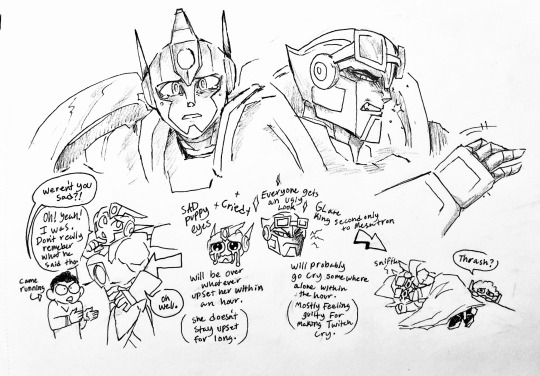
Had a tiny bit of angst cross my brain, but since I can’t take myself seriously, you’ll just have to take this weird diagram comic thing. Warning, long read.
So I was basically thinking about if twitch and thrash got into a bit of a fight. And don’t get me wrong, they have argued before, but this argument may have gotten a bit out of hand.
Dot is at work, kids are at school, so bumblebee and Alex take their eyes off the terrains for a little bit and boom! Fight. Not so nice words were exchanged and both parties were bitter at the end. The argument was so bad, Robby and Mo felt it at school.
Twitch ended up crying and that made thrash back off but also double down. ( if you have siblings you know these fights very well.) twitch doesn’t stay angry for long tho but doesn’t go looking for thrash either, she’d much rather wait for Robby and Mo to come back. She’s probably still annoyed with him.
Thrash however holds on to his feels much longer. He’s mad at twitch but after a while really starts feeling bad for making her feel like that, but he’s still frustrated. I mixing pot of all this thinking and feeling leads to him finding a spot to have a little cry himself.
No idea what they were fighting about. But in the end it was probably silly and not worth getting that worked up over it. That’s usually how that stuff goes down.
God I love feelings. I don’t know why I’m writing all this when you can clearly see what’s happening in the picture. But idk, it’s 1am and I am talkings about it.
#my art#bee talks#transformers#earthspark#transformers earthspark#mo malto#robbie malto#thrash#thrash malto#tfe#twitch#twitch malto#oh boy long post#excuse any spelling errors. I do not care#really want the feelings#a good sibling fight#mights add a resolution but idk u tell me#I had a lot to say about this
199 notes
·
View notes
Text

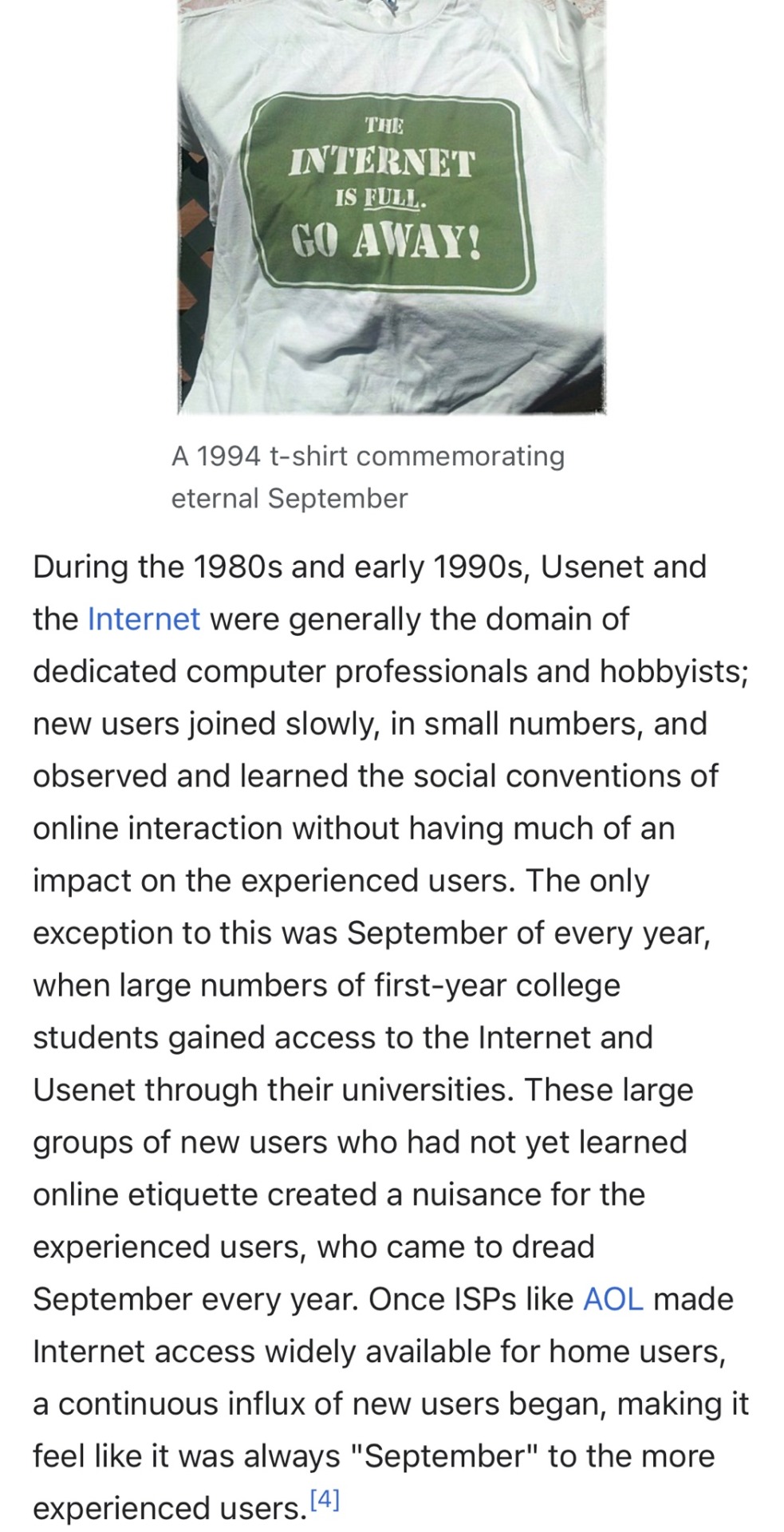
hmm.
#STOP WITH THE GREENDAY JOKES IVE HAD ENOUGH#internet#old web#old internet#was thinking about how 'lurk more' used to be a common phrase so people would learn forum etiquette before posting#but now..#the fact that the phrase 'netiquette' has died out entirely says a lot i feel
18K notes
·
View notes
Text
The funniest thing in the world to me is when people write mermaids that are bothered by humans eating fish. Like do you think fish don’t eat each other? The ocean is full of little freaks that will eat whatever or whoever the fuck will fit in their mouths. If the mermaids haven’t been eating fish this whole time what do you think they’ve been eating? If the answer is humans, that doesn’t make it any less funny. They’ll eat the species that looks like the top half of them but won’t eat a species that looks like the bottom half? Peak comedy.
#mermaids#mythical creatures#edit:#okay a lot of you have had good ideas about why mermaids possibly would be bothered by humans eating fish#so i will amend my original statement to say it’s funny and it doesn’t make any sense#unless you outright in-universe explain it#like don’t just fall back on the excuse of bUT tHeIR OUr unDERsEa BrOTherS#make it a part of their culture or physiology#if they haven’t been eating fish explain what they HAVE been eating and why#make it interesting
20K notes
·
View notes
Text
Please, if you can, take a moment to read and share this because I feel like I'm screaming underwater.
NPD (Narcissistic Personality Disorder) stigma is rampant right now, and seems to be getting progressively worse. Everyone is using it as a buzzword in the worst ways possible, spreading misinformation and hatred against a real disorder.
I could go on a long time about how this happened, why it's factually incorrect (and what the disorder actually IS), why it's harmful, and the changes I'd like to see. But to keep this concise, I'll simply link to a few posts under the cut for further reading.
The point of this post is a plea. Please help stop the spread of stigma. Even in mental health communities, even around others with personality disorders, in neurodivergent "safe" spaces, other communities I thought people would be supportive in (e.g. trans support groups, progressive spaces in general), it keeps coming up. So I'm willing to bet that a lot of people on this site need to see this.
Because it's so hard to exist in this world.
My disorder already makes me feel as if I'm worthless and unlovable, like there's something inherently wrong and damaged about me. And it's so much harder to fight that and heal when my daily life consists of:
Laughing and spending time with my friends, doing my utmost best to connect and stay present and focused on them, trying to let my guards down and be real and believe I'm lovable- when suddenly they throw out the word "narcissist" to describe horrible people or someone they hate, or the conversation turns to how evil "people with narcissistic personality disorder" are. (Seriously, you don't know which of your friends might have NPD and feels like shit when you say those things & now knows that you'd hate them if you knew.)
Trying to look up "mental health positivity for people with npd", "mental health positivity cluster bs", only to find a) none of that, and b) more of the same old vile shit that makes me feel terrible about myself.
Having a hard time (which is constant at this point) and trying to look up resources for myself, only to again, find the same stigma. And no resources.
Not having any clue how to help myself, because even the mental health field is spitting so much vitriol at people with DISORDERS (who they're supposed to be helping!) that there's no solid research or therapy programs for people like me.
Losing close friends when they find out, despite us having had a good relationship before, and them KNOWING me and knowing that I'm not like the trending image of pwNPD. Because now they only see me through the lens of stigma and misinformation.
Hearing the same stigma come up literally wherever I go. Clubs. Meetings. Any online space. At the bus stop. At the mall. At a restaurant. At work. Buzzword of the year that everyone loooves loudly throwing around with their friends or over the phone. Feels awesome for me, makes my day so much better/s
I could go on for a long time, but I'm scared no one will read/rb this if it gets too much longer.
So please. Stop using the word "narcissist" as a synonym for "abusive".
Stop bringing up people you hate who you believe to have NPD because of a stigmatizing article full of misinformation whenever someone with actual NPD opens their mouth. (Imagine if people did that with any other disorder! "Hey, I'm autistic." "Oh... my old roommate screamed at me whenever I made noise around him, and didn't understand my needs, which seems like sensory overload and difficulty with social cues. He was definitely autistic. But as long as you're self-aware and always restraining your innate desire to be an abusive asshole, you're okay I guess, maybe." ...See how offensive and ignorant that is?)
Stop preventing healthcare for people with a disorder just because it's trendy to use us as a scapegoat.
If you got this far, thank you for reading, and please share this if you can. Further reading is under the cut.
NPD Criteria, re-written by someone who actually has NPD
Stigma in the DSM
Common perception of the DSM criteria vs how someone may actually experience them (Keep in mind that this is the way I personally experience these symptoms, and that presentation can vary a lot between individuals)
"Idk, the stigma is right though, because I've known a lot of people with NPD who are jerks, so I'm going to continue to support the blockage of treatment for this condition."
(All of these were written by me, because I didn't want to link to other folks' posts without permission, but if you want to add your own links in reblogs or replies please feel free <3)
#actuallynpd#signal boost#actuallyautistic#mental health awareness#narcissistic personality disorder#people also need to realize that mental health professionals aren't immune from bias#(it really shouldn't come as a shock that the mental health field has a longstanding pattern of misunderstanding and mistreating ppl who ar#mentally ill or otherwise ND)#the first therapist i brought up NPD to like. literally pulled out the DSM bc she could barely remember the criteria. then said that there'#no way I have it because I have low self-esteem lmaoooooo#anyway throwback to being at work and chatting with a co-worker. and the conversation turning to mental health. and him saying that#he tries to stay informed and be aware and supportive of mental health conditions & that he doesn't want to be ignorant or spread harmful#misinformation. and then i mentioned that i do a lot of research into mental health stuff and i listed a bunch of things. which included#several personality disorders. one of which was NPD.#and after listening to my whole ass list he zeroed in on the NPD and immediately started talking about how narcissists are abusive and#he knew someone who had NPD and how the person who had it had an addiction and died from the addiction in a horrible way and he#was glad he did#fun times#or when i decided to be vulnerable and talk abt my self-criticism/self-hatred bc i knew my friends also struggled w that and i wanted to#support them by sharing my own coping methods. and they both(separately!) started picking and prodding at my npd through the lens of stigma#bc i'd recently opened up to them abt having it. they recognized self-hatred as a symptom and still jumped on me for it. despite me#trying to share hurt vulnerable parts of myself to help them and connect with them.#again..... fun times
7K notes
·
View notes
Text
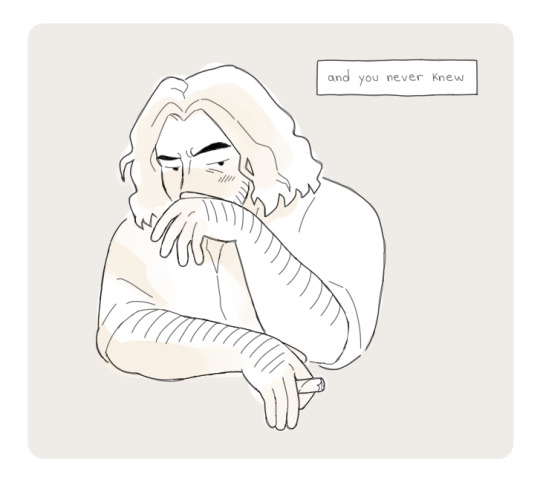
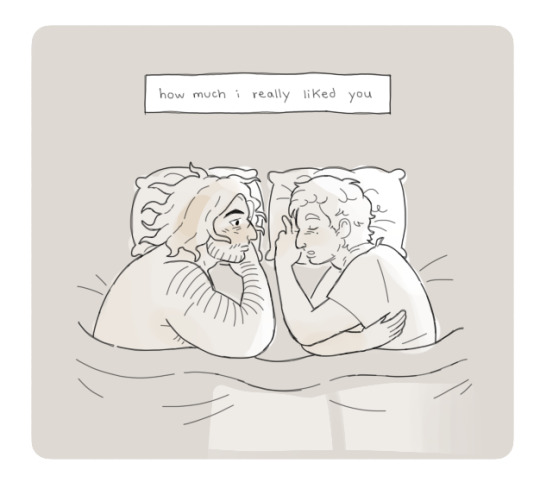
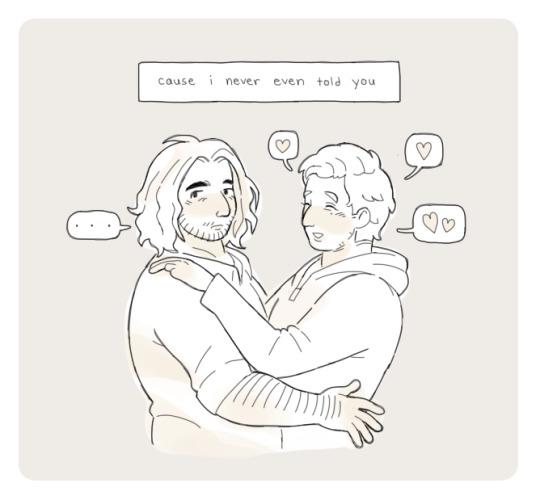

different POV of this comic
x
#ethan winters#karl heisenberg#wintersberg#resident evil#resident evil fanart#rebhfun#resident evil village#resident evil 8#re8#i dont think karl would ever be the kind of guy to outwardly verbally say “i love you”#not to say he DOESNT love ethan#he just has a lot of trouble saying those three words out loud lol#he shows his love in a different way but i think its hard sometimes#had a conversation with my friend and i think if ethan and karl were to get into a argument karl woul definetly not apologize#he would definetly feel bad and sulk a lot#but i dont think he would ever bring himself to say hes sorry#hes a little too arrogant and emotionally stunted to do that#sorry i like thinking about all the aspects of relationship dynamics#hed apologize by making ethan a robot that kills people who r mean to him IDK LOL
2K notes
·
View notes
Text
Prompt 261
“So is no one going to talk about the eldritch space child or…”
“I mean, do you want to get between a child and Batman? I think the only one who could even get close right now is Superman…”
“No you’re right, I think- oh my god the eldritch space child is playing with batman’s bat-ears and he’s not doing anything about it what the fuck I thought only Robins could get away with that-”
#DCxDP#DPxDC#Prompts#Alfred is Clockwork#AndCW having adopted Danny means Danny gets to meet his new big brother from another timeline#Bruce (Once Alfred confirms) is absolutely attached within moments#Autistic bois unite & talk for hours about hyperfixations#Clark has had time to make an entire homemade pie at this point#No Danny isn’t ghost king nor is Clockwork Cronus#Bruce: I have only had a baby brother for 5 hours but if anything happens to him I will let my kids break all the rules & kill everyone her#Signal: Yeah definitely Alfred’s he glows like him and everything#The rest of the bats: Alfred does what now-#Danny with dozens of big star eyes to Bruce: How would you feel about sisters#Bruce holding 3 children & 1 young adult: I am big brother now#Alfred scathingly says that Someone in the family *cough Jazz cough* will at least finish college & get their degree#Sometimes CW enjoys turning off his future-vision and vibing as a mostly-mortal#And Gotham is an old war buddy of his (Yes Gotham is the city equivalent of an Ancient) from the [Redacted] era of the Realms#And xer son & daughter are adorable- Bludhaven & Arkham love the vigilantes lots
2K notes
·
View notes
Text
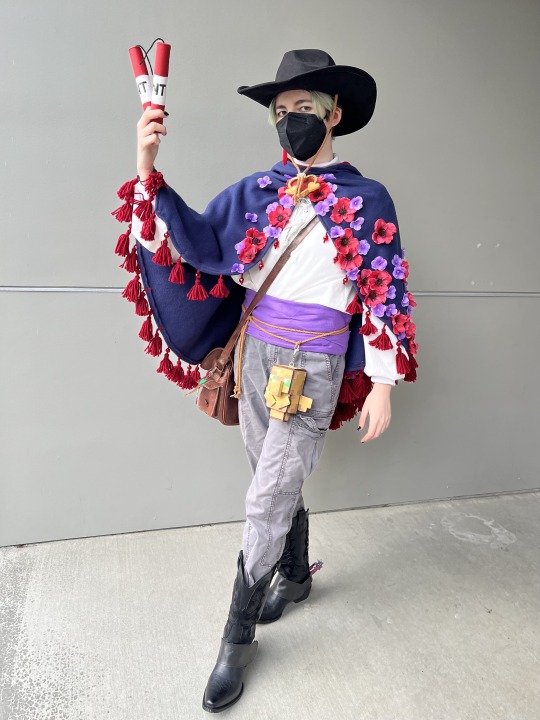

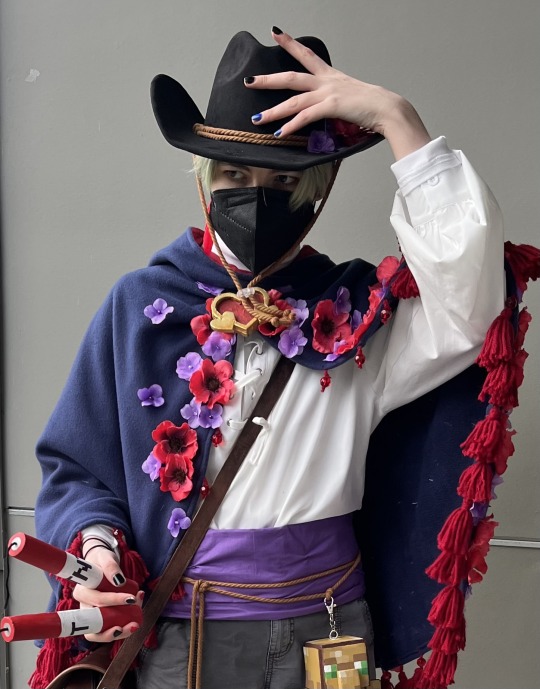
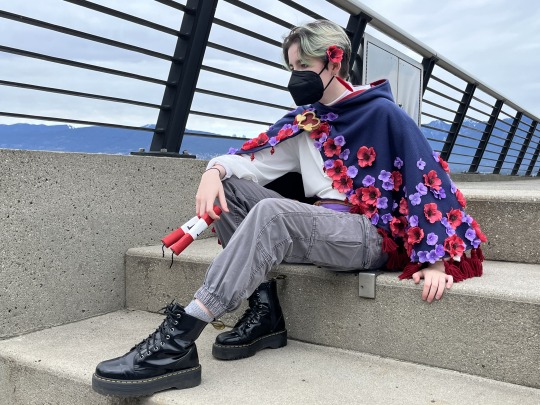
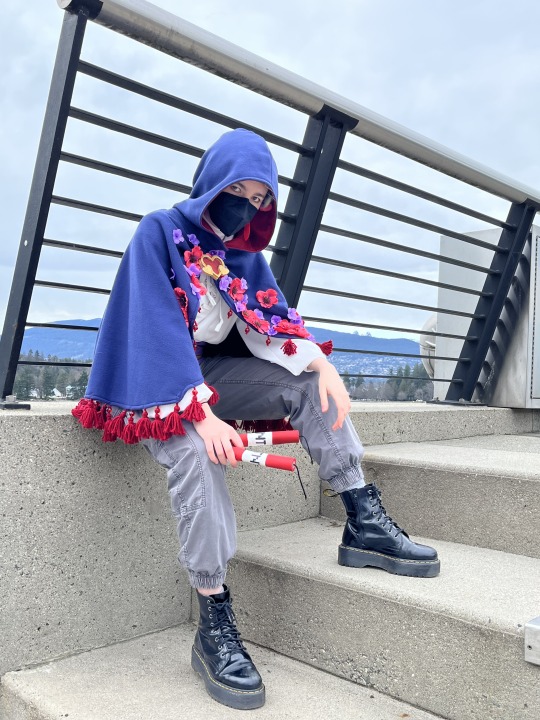
"she's dead scar.... you won."
my cosplay of scar's secret life red life skin!
#goodtimeswithscar#goodtimeswithscar fanart#gtws#goodtimeswithscar cosplay#gtws fanart#secret life#secret life fanart#life series cosplay#secret life smp#the life series#cosplay#seta art :)#if anyones wondering about how many flowers or tassels are on that cape... lets just say a LOT BSDJFHBDS#also!! to all the people i saw at the conventions i hope yall had as great of a time as i did :)#& if anyone has any questions as to how parts of this were constructed i would be happy to answer questions!#(and thank you to hoffen for answering my silly questions about the skin sbdjfhbs)
1K notes
·
View notes
Text

The monster high couple ever imo
#i imagine robecca's saying something sappy about Elissabat in this moment#the whole 'What if she HAD been the vampire queen' lore of the new skullector doll has had me thinking about these two a lot actually#theyre so in love to me you dont even understand#monster high#robecca steam#elissabat stoker#my art#fanart#steambat
2K notes
·
View notes
Text

Felt a bit nostalgic watching RT shut down…Here are the og faves again for old times sake 💙
#rvb#agent washington#agent Carolina#lavernius tucker#michael j caboose#epsilon#my art rvb#ahhh a lot of feelings…of course I stepped away from rt as a company a long time ago#but RvB is special to me!! it was my first fandom experience ever#and the community here on tumblr specifically was so instrumental to me growing up#I really could not have asked for a better community of artists and writers to grow up in. I know it sounds like platitudes when I say#that everyone was super nice and talented but REALLY. People were so kind to me and somehow I became well known despite#my art and writing and me in general still being immature and hashtag cringe#I found my creative legs and#people would respond to my stuff with walls and walls of support in the tags and we would do exchanges and events every year#I made my first lyric comic and it’s still doing extremely well on YouTube even today!! my dad who passed away recently always loved it#and my favorite RvB writer came out of hibernation to write me a bunch of text wall asks about it#I’ve never had another fandom experience quite like RvB#I still keep in touch with many of my friends from that time period even though we’ve all moved on the other things#these guys will always always have a place in my heart#so long reds and blues….
1K notes
·
View notes
Text
Toph Beifong doesn’t hold up as disability representation - Disability in the Media

[ID: A screenshot of Toph, a twelve-year-old girl with black hair in a loose, green and tan short-sleeve shirt and shorts, cheering in an arena. Next to text written in a rough, blocky font: "Disability in Media - Toph Beifong Doesn't hold up as disability representation" /End ID]
Avatar the Last Airbender is one of my all-time favourite TV-shows, and Toph is still easily one of my favourite members of Team Avatar. I was a few years younger than Toph when the show first started airing, and being a disabled kid who was into martial arts, constantly being dismissed by my able-bodied opponents and teachers, meant that I connected very strongly with her right from the get-go.
But upon my last couple of rewatches of the series, I began to come to the realisation that my opinions on Toph as a shining example of good disability representation were... well, pretty heavily influenced by my nostalgia for the show and that many aspects of Toph's character just don't hold up today. Which, honestly is fair, the show is nearly 19 years old (if it were a person in my country, it would be old enough to drink) and I think it's pretty ridiculous to expect every part of every character from an 19 year old show to age well. So today I wanted to talk about the things I think Avatar the original Last Airbender did right with Toph, where I think they missed the mark, and what changes I think would need to be made to Toph to make her work for a modern audience.
So let's start with why I think Toph doesn't really hold up as "good disability representation" today, and the elements of her character that just haven't aged as well.
For me, one of the biggest issues I noticed upon rewatching the show, is how often we are told (often by Toph herself) that she is blind, but how infrequently we are actually shown it's impact on her life beyond her bending or outside of jokey contexts. Outside of her bending, we only ever see her blindness impacting her ability to do things like read or write, otherwise, she functionally has full vision -so far as the audience is informed - with the only exceptions being when she's in the air or water (e.g. on Appa or in the submarines) or in loose soil (e.g. the desert). Having places and circumstances where she doesn't have access to her power that allows her to "see" was a step in the right direction, but I do think it would have been better if her seismic sense wasn't quite as accurate, even in the most ideal of circumstances.
But why? Well, I think Suki explains it really well, long before Toph is even introduced. when Sokka says "I should have seen you as a warrior instead of a girl" Suki stops him and says "I am a warrior, but I'm also a girl". Being a warrior and a woman are both important parts of Suki's character, and only recognising her as one or the other means ignoring a big part of who she is, and the same is true for Toph. Being blind is a big part of toph's character that has informed a lot of her life, but so is being a warrior and bending master. Many people see Toph as a warrior or fighter, but ignore her disability, but both are important. She's disabled, and a warrior, and those things don't cancel each other out, the same way being a warrior doesn't diminish Suki's status as a woman.
When the show was still airing though (and even still today) it was very common to see non-disabled fans of the show exclaiming that they honestly forget that Toph is even blind sometimes, with many people going so far as to say that she's not even disabled (and that this was a good thing). While I do think some of that comes from the fact they weren't used to seeing a disabled character as both disabled and an active participant in these kinds of stories, I do think this mostly happened because of the show's lack of, well, showing the impact of her blindness on her daily life and allowing her earthbending and seismic sense to erase the effects of her disability to some extent. It's much harder to forget a character is blind when it impacts their daily life in ways that are shown to the audience. This doesn't have to be in big, showy ways mind you, showing things subtly but consistently works way better than one "very special episode" type setup.
In the show as it is though, the seismic sense functionally gives Toph a perfect image of her surroundings until it's just not available anymore for *plot reasons*.

[ID: A black and white shot of Toph and how she sees the oponent she's fighting, with shockwaves radiating from him towards her to indicate how she's interpreting the scene. Her foe has jumped into the air and now has his hand dug into the ground of an arena, about to launch rocks towards her. /End ID]
In many ways, her picture of the world is better and clearer than what the non-disabled characters can see, leading to this feeling of her disability being erased. It may have been better though if the seismic sense could give her a general idea of big things in her immediate vicinity but she still missed the finer details, functioning at least a little bit more like a tactile/earthy-vibration version of the limited sight some legally-blind people have in real life. Things like a person's position, movement and overall pose would still be "visible" to her in a general sense, as well as big things in the environment (including things underground, since there are a few plot-points that require that), but smaller things like details about objects and creatures, people's facial expressions or what they're doing with parts of their body that have no direct contact with the ground (like their hands) is less clear.
On top of this, she may struggle to detect smaller, lighter objects or creatures that realistically wouldn't cause much of a vibration at all. creatures as small and as light as Momo and Hawky for example might be detectable, but "fuzzy" to her, and anything smaller might make enough of a vibration to tell her it's there when it moves, but not enough for her to be able to tell what specifically it is without some other cue (such as sound). There are a few moments in the show that seem to imply this is what they were initially going for, but it's not really consistent, and is directly contradicted in her debut episode, "the blind bandit" when she explains that she can even "see" something as small as the ants off in the distance.
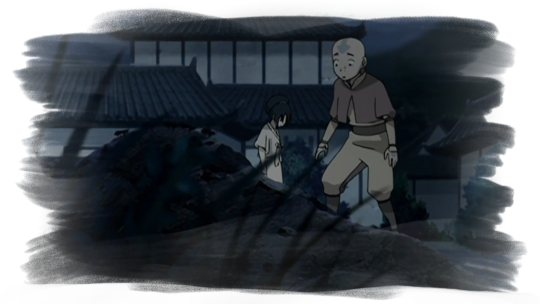
[ID: A shot of Aang, a twelve-year-old bald boy with an arrow tattoo on his head, dressed in a yellow and orange outfit, standing with Toph at night. In the foreground is an anthill will a trail of ants, which Aang is looking for. /End ID]
With an adjustment like what I'm suggesting though, she still serves her narrative purpose of teaching Aang the importance of being able to wait and listen - possibly even more so, as her needing to wait and collect more information in order to get a clearer image before striking, would back-up what Bumi tells Aang that he needs in an earth bending master. It would also still help to illustrate the connectedness of the world, a theme Toph continues to embody heavily in The Legend of Korra, while still showing the ways her disability impacts her more frequently.
When I talked about the "super-crip" trope a while back, I mentioned that one way to avoid the more harmful elements of the trope (where the character's disability is erased by their powers) is to use the ability in question more like a mobility or disability aid than a straight-up cure. The power should help them, but shouldn't make their disability redundant. People are creative and we would find ways to use a superpower or magic to help with our disabilities if it were available in real life, but what's the point of including a disabled character if you're just going to functionally erase their disability? For a character like Toph, I think this is the kind of approach that should be taken with her. Her seismic sense still helps her, but it's not a perfect replacement. (Ironically, I did use Toph as a "good" example of that trope, but I do think after this last rewatch, for the reasons I'm discussing here, I might have to backtrack that a bit).
I considered giving an alternative approach here, to keep the sensitivity of toph's seismic sense as it is in the show as is, but giving it draw-backs such as making her susceptible to sensory overload similar to what autistic people experience. However, while replacing one disability with another can work for some characters and stories, I don't think it's the best adjustment to make for Toph or any blind character, largely thanks to this also being a trope. The "blind (or d/Deaf) person who's other senses become super-human to make up for it" trope is very common in fantasy, sci-fi as well as older martial arts films, and while I'm not really the best person to cover it, I do know that members of both the blind and deaf communities have expressed a lot of frustration with it. Toph already falls into this trope quite a bit, and any suggestions I could make would have just dialled that element up to 11, and fixing one problem with another is never a good idea.
Another thing that actually did bug me for a while, even before my most recent rewatch of the show, is how Toph is treated on the rare occasions she does point out something won't working for her. There are a number of times where Toph advocates for herself and points out that something The Gaang is doing isn't accessible to her or sets a boundary to do with her disability, and she's either left behind, her concerns are brushed off or she's ignored entirely. The three most noticeable examples of this are in the Episodes "The Ember Island Players," "The Library," and Toph and Katara's segment of "Tales of Ba Sing Se."
In the Ember Island Players, Toph complains that the seats they have for the play are too high up and too far away, and she's unable to "see" what's happening on stage. Her friends don't really take any notice of her though except for Katara who tells her not to worry, "I'll tell your feet what's happening."

[ID: A shot of Katara, a fourteen-year-old girl with long brown hair and blue eyes, sitting with Toph, who is sitting with her arms crossed, annoying in a theatre seat. Both Toph and Katara are wearing red and gold, fire-themed outfits. Katara is looking at something off-screen. /End ID]
My problem here is that this particular kind of situation is something that is familiar to a lot of disabled people. Even the least independent disabled people I know get annoyed when their access needs or requests for accommodations, even among friends, are ignored and their pushback is brushed off with "don't worry, I'll just help you!" It's one of the first things that many disabled people tell non-disabled folks wishing to be better allies to us: you offering help instead of actually accommodating us isn't a good thing. We don't want to rely on others if we can avoid it, because honestly, non-disabled people often aren't very good at actually helping or in this case, relaying information to us without training and more often than not, it just results in us being left out. I find it very hard to believe a character as independent as Toph would accept that without any protest, especially considering that is pretty much exactly what ends up happening (even if the show didn't really acknowledge it). Katara never actually conveys anything about the play to Toph, except when she's attempting to throw Toph's words back in her face when she asks for clarification about the actor playing her - which ends up backfiring on her.
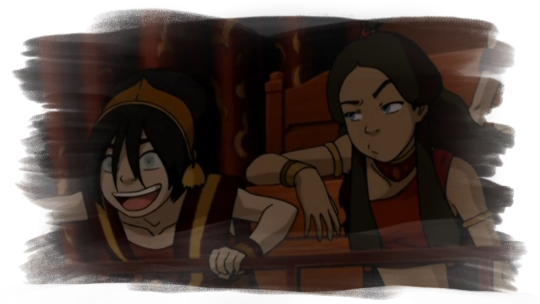
[ID: A shot from the same location as before, this time Toph has a huge smile on her face and is leaning on the balcony excitedly while Katara is leaning towards her, annoyed by her reaction. /End ID]
While it would have been better if Toph was actually listened to, it would have been…fine? if a justification was given for why they had to sit there (e.g. to avoid being recognised), if Katara had actually described the play for her. This wouldn't have been ideal, but it would have been better at least. In real life, many movies, TV shows (including this show's sequel series, The Legend of Korra) and other forms of visual media have an Audio Description track that does exactly that. If they weren't going to move for Toph to be able to see better, having Katara describe the play could have introduced kids to the fact this is an option. but instead it's brushed off, and I'll admit, it left a bit of a bad taste in my mouth, even back in 2006.
The Library is a bit more forgivable in my opinion, since Toph is still new to the group, but in this episode, she states that she doesn't want to go inside the spirit library because she isn't able to read and therefor there wouldn't be anything for her to do. However, it still would have been nice to see her friends consider this at all before they actually arrived. They could have (and should have) still gone, but some acknowledgement that they at least thought about the inclusion of their disabled friend would have been nice.

[ID: A shot of Aang, Katara, Sokka and another man are talking while looking down at a map on the table. Meanwhile, Toph is sitting on the other side of the table, completely disinterested as she sips from a large ice cup with her feet up on another chair. /End ID]
Alternatively, I do feel like Wan Shi Tong, a self-proclaimed all-knowing-spirit or his assistants would have been able to point her in the direction of something to interest her, since he does imply books aren't the only form of knowledge he collects.
The reason I mention this though is two-fold.
In real life, disabled people are very often left out of "fun" group activities, whether that be in formal settings or in casual ones, like hanging out with friends. If the episode had been framed as "the Gaang learns about the library and decides to track it down," I might have been less critical, but it's specifically framed as something that at least starts out as a kind of break for the team where they all take turns picking out fun things to do so they can rest, and Toph's access needs not being considered at all until they're already there hits a bit close to home, especially since they just end up leaving her outside. Secondly, there's also a stereotype that disabled people (and especially blind people) don't belong in academia and places of learning, such as in this case, libraries. This stereotype is about as old as the concept of organised institutions of learning, and definitely isn't unique to AtLA, but the assumption is often that disabled people wouldn't be interested in more formal methods of learning, so it's not worth accommodating us. With blind people in particular, when I've seen this in media, the premise is often "well I can't read anyway so why bother?" which Toph definitely falls into here with no push-back against the trope.
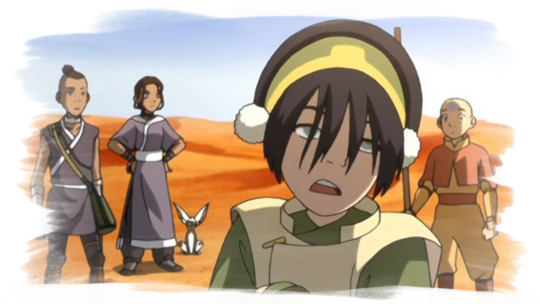
[ID: A close up of Toph and the rest of the group, Katara, Sokka and Aang standing in a desert. Toph shrugs, looking bored, while the others looks confused and surprised with the exception of Katara, who looks mildly annoyed, standing with her hands on her hips. /End ID]
It does make sense that she would have been resistant to going in, and I'm not saying this episode should have turned Toph into a bookwork akin to Wings of Fire's Starflight (another blind character) or anything. But there was a chance in this episode to push back against some of these assumptions, and I think it's a shame they missed it. How cool would it have been if Toph had mentioned not feeling welcomed in more formal learning spaces because of her disability, which was just reinforced by the way her old earthbending instructor and her parents treated her. She decides to go inside the library anyway as "backup" in case something goes wrong, grumbling about it the whole way down. Wan She Tong starts his introduction mostly the same way, saying humans aren't welcome and Toph makes a snarky comment about it. Wan She Tong, equally offended that this human thinks he, the all-knowing-spirit, wouldn't have considered something, shoots back with an annoyed comment about humans being so self-centred. He explains that spirits come in all shapes and sizes, and not all of them have eyes, but they can still access his library. She's not the first sightless being in his study, and he-who-knows-ten-thousand-things knows this too. Once everyone is permitted entry, one of the knowledge seekers shows her to a series of slates about a lost earthbending form that she can actually read (or at least, "see" the pictures on) because it's carved. Or instead of a slate, it's a series of statues outlining the form, similar to what Aang and Zuko find in the episode "The Firebending Masters". Perhaps this form is something that helps her develop metal bending later on, and lays the groundwork for Toph becoming interested in teaching in the comics.
And finally, Toph and Katara's segment of Tales of Ba Sing Se. Katara convinces Toph to go get a makeover with her as part of a girl's day. Overall, this segment of the episode is pretty nice, and I liked that they showed that a person's gender expression (in this case, being a tom-boy) doesn't mean they can't like things outside of what we usually associate with that. Tom-boys can like girly things on occasion, and vice-versa, and I think this is an example of an episode that would seem a bit ham-fisted today, but honestly, was needed in 2006. However, there's a throw away joke where Toph says "as long as they don't touch my feet," and it immediately cuts to show spa workers filing down the calluses on her feet in a way so painful several staff are required to hold her down.
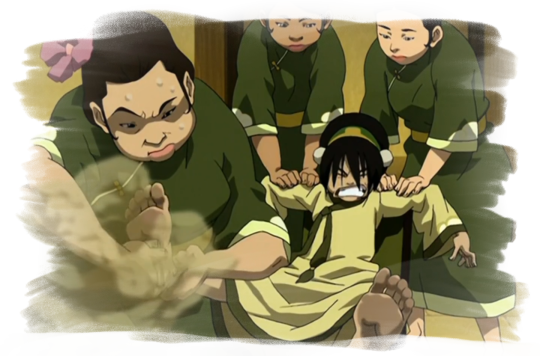
[ID: An image of Toph in a bath robe being held down in a chair by two spa workers while a third scrubs at her feet so hard that she is sweating. Meanwhile Toph is fighting against the two holding her down and has a facial expression like she is in a great deal of pain. /End ID]
this might be a minor thing in the grand scheme of the show, but it's still another example of Toph's boundaries about her disability and her access needs being disrespected by her friends, which the show just doesn't acknowledge it at all. People ignoring Toph's wishes about a part of her body she depends on in a much more direct way that others do is played off like a joke in a montage of otherwise enjoyable and goofy activities and this is a very, very common experience in disability circles.
There are a number of other, much more minor issues that show up with Toph as well, such as the fact she's the only one of the main cast who never has an on-screen (or on-page) relationship. not in the original show, not in any of the comics and not in The Legend of Korra. Again, it's not a big issue on it's own, especially because in AtLA, she's young enough where it's possible that she was just not interested yet, and she does have kids in The Legend of Korra where she mentions a relationship with a man named Kanto (Lin's father). So it is implied she does have some form of relationship eventually, but the issue is that it's never shown on screen or on the page. This feeds into a wider pattern in media of disabled characters being the only ones in their respective cast not given on-screen romantic relationships in stories, and so I still think it's worth pointing out, especially since the creators have had a lot of opportunities to correct that by now.
Toph is also portrayed, pretty much undeniably, as the best earthbener in a way that, at times, comes across almost like the creators felt like they need to compensate for her being on the team "despite" her being blind. This trope is one that I think Toph, at least partially, helped to popularise with the current generation of story tellers: The Disabled Savant. In this trope, disabled characters aren't really given the same room for growth as other characters; they aren't permitted to be average or still learning, they start good and get better. If they do progress, they often become the best, which is the case for Toph. To be fair, everyone in the The Gaang is the best at their respective skill by the end of the first series, which is why I say this is a minor point. She dose, however, have the least amount of on-screen growth in skill out of the whole team. Katara starts out barely able to lift any water at all, let alone actually bend it. Sokka is skilled with weapons from the start but does get his butt handed to him a number of times by others with more experience than him whom he learns from throughout his story arc. Zuko spends most of the early-to-middle of the show having things "blow up in his face" (to use his own words) and being belittled by his family of prodigies. While Aang is an airbending and, to a lesser extent, waterbending prodigy, he fails at pretty much everything else for a while before he starts to find his confidence - especially earth and firebending, not to mention the entire situation with locking himself out of the Avatar state. Toph is the only one who doesn't seem to fail or struggle all that much from a combat perspective. She does grow and improve in her bending (she invents metal bending after all) but she never has any moments where she really messes up or even struggles in combat all that much compared to the others.
All of these points and criticisms I've mentioned are not necessarily big in and of themselves, but when looked at together, they build up to create some issues with how Toph is depicted and how the people around her treat her disability
So that's it then? Toph is bad disability rep and Avatar should be "cancelled"?
God no. Like I said at the start, I still adore Toph and Avatar as a whole, but the show is a year away from being two decades old, it's bound to have some elements that don't hold up and I think it's worthwhile discussing them, specifically because I love the show and it's characters. Despite all the negativity I've brought up, I do think there are a lot of things AtLA did well with Toph too.
I've mentioned a few times that we rarely see how Toph's blindness impacts her life outside of her bending and combat abilities, and there's a reason I made that specification. Unsurprisingly, if you know much about the show's development, the ways in which Toph’s blindness and seismic sense impacts her bending and fighting style is one area where the show really does shine, and I still think that is worth a mention. The various types of bending are based on different styles of martial arts, specifically, different types of Kung Fu. Most earthbending in the show takes heavy inspiration specifically from Hung Ga, but Toph is different. Her bending heavily references Southern Praying Mantis Kung Fu, something unique to her within this world.
The reason for this (outside of simply wanting her to be visually distinct) was because the show’s creators made sure to consider what limitations Toph might have and what parts of the more common earthbending styles wouldn't work for her. Since her connection to the earth was critical in order for her seismic sense to work, they decided on a style that would keep her feet on the ground more, prioritised strong stances with minimal jumping and put more focus on attacking with her upper body. While not an intentional choice, the style they went with for Toph, according to the show's head martial arts consultant, Sifu Kisu, was supposedly developed by a blind woman in real life, at least according to legend. The creators also made further adjustments to the style with the help of martial arts consultants and just watching Toph fight is evident that a lot of love and care was put into the decisions made on that front.
I also appreciate that Toph's disability wasn't off-limits to joke about.
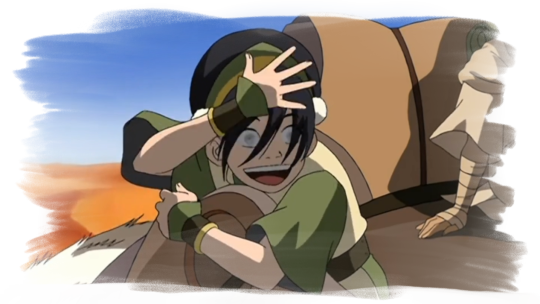
[ID: A picture of Toph waving her hand in front of her face with an exaggerated smile to remind the others she's blind. /End ID]
As I already mentioned, they didn't land 100% of the time, but lot of shows are afraid to use disability as a source of jokes, which would have felt weird and out of place in a show like Avatar. I see this hesitance in real-life too; people get extremely uncomfortable when I joke about my own disabilities and I've heard several people and even disabled comedians talk about the same observation. My last video on Tik Tok that got outside my usual audience was a joke about my prosthetic leg, and every single stictch and duet I received was people saying some variation of "I'm such a bad person for laughing!" "I'm going to hell!" or just straight up asking if they're aloud to laugh. If I didn't want you to laugh, I wouldn't have posted the joke! But joking about disability does make it more approachable.
Despite how often Toph and the others made blind jokes though, outside of the one instance I mentioned earlier, they never felt mean-spirited or like they were punching down. Even when a very sleep-deprived Katara was intentionally trying to be.
I think it's also worth keeping in mind the context of the media landscape when Avatar The Last Airbender was airing. Today, characters like Toph are very common, so much so there's a whole trope about them (super-crips) but at the time, having a character with a major disability be a main character in an action-orientated kids show like Avatar was really rare. She wasn't the first of course, but a lot of the time, if they were included, they were almost certainly sad and depressed, wishing for a cure or they were designated to the roles of "Guy in the chair" (which is a character, usually a tech person, who helps from the background), inspiration, scary villain fake-out (or other variations of "creepy" character) or the actual villain. Having a character that was not only comfortable in her skin as a disabled person, who didn't want or need to be "fixed" or "cured" to be directly involved in the story, and who's main obstacle (at least in season 2) were how the people around her treated her, was pretty ground-breaking at the time (pun not intended) and went against the most prevalent stereotypes of it's day.
And I really want to emphasise that. For many Millennials and older Gen Zers, myself included, Toph was the first character that didn't tell us we were broken and needed to be fixed in order to be part of the group (even if they slipped up with that messaging occasionally). Prior to seeing Avatar, I honestly thought there was something deeply wrong with me for being happy with my life (a reminder, I was 10 years old when this show first started airing), because every other disabled person in the media only ever talked about how much worse their life was because of their disability, how much they hated it and how much they hated themselves. Many outright said that they wished they had died rather than become like me. Toph wasn't the first to go against those tropes, but she was the first example of a disabled character who wasn't like that many people my age saw. Did she do it perfectly? Hell no, but personally, back then, I was happy to have a character who maybe over-corrected and took things a bit too far than another sad character talking about how lives like mine weren't worth living.
I also deeply appreciated that Toph did struggle with her independence, at least initially, and where to draw the line with accepting help. Because of how much she'd been coddled and overprotected as a little kid, she saw any attempt at people being helpful and working as a team as them trying to baby her. It was very on the nose, but I liked that the show gave her an episode just dedicated to realising that it's ok to accept help. Again, this is a bit of a story telling trope today, but having the disabled character realise that it's ok to accept help, and to do it without talking down to them or saying that them wanting independence was bad, was a refreshing change compared to what was around at the time.

[ID: a zoomed out image of Toph, standing before her parents with Aang, Katara and Sokka standing behind her. /End ID]
While I think the show's creators could have benefited from consulting with disabled people and specifically blind people the same way they brought in consultants for the martial arts featured in the show, it's very clear to me that the intention behind Toph's character was good, and that actual effort was put in to make sure they depicted her well, even if some of it was a bit misplaced. It's also worth noting that the groundwork for a lot of my suggestions is already in place, they just didn't follow it all the way through.
Overall, I'd say Toph was good for her time, and she's what was needed in the 2000's, even if she doesn't hold up as well today. I also think it speaks to how far we've come in terms of disability representation. When I first started engaging with the online fandom directly, almost no one, even other disabled people, argued that Toph wasn't good representation, because honestly, the bar was on the floor and we were just happy to have something different. But now there are options, and the standards are higher, and that's so, so good. It means that people, even in the media, are starting to listen and be more thoughtful about their depictions of disability than we were in 2006.
And finally, I want to really quickly mention The Netflix adaptation of Avatar. A few people have asked me now what I think they should do with Toph when they get to her, and what my predictions about the show are. I'm not going to talk about my predictions here, because this post is already way too long and that's not what this is about, but I don't think the suggestions I made today would necessarily work in this particular remake, primarily because of the tonal differences. Some adjustments definitely could, such the other characters doing a better job at listening to Toph when she points out inaccessibility and them actually considering her in the first place, but others might be harder to balance. The original show could get quite dark and serious at times, but it was primarily a light-hearted adventure story for kids. From what I've seen of the live action remake though, they're more heavily leaning into those serious elements - for better or for worse, and as such, trying to tone Toph down in the specific ways I mentioned might not balance out as well as it would in the original show. At the very least, the specifics would need to be different. To be honest, I'm not entirely sure what approach they should take, that's not really the point of this post, but I did want to quickly address it to avoid confusion. My suggestions today were specifically on how to approach the cartoon version of Toph for a modern audience, and were not meant to be read as suggestions on how her live-action counterpart should be depicted.
#writing disability with cy cyborg#Wow I had a lot more to say about this than I thought (I think this is my longest post to date lol)#writing disability#disability representation#writeblr#writing#Avatar#avatar the last airbender#atla#Long Post#toph#toph beifong#the gaang#Animated Avatar#disability in media#fantasy
577 notes
·
View notes
Text
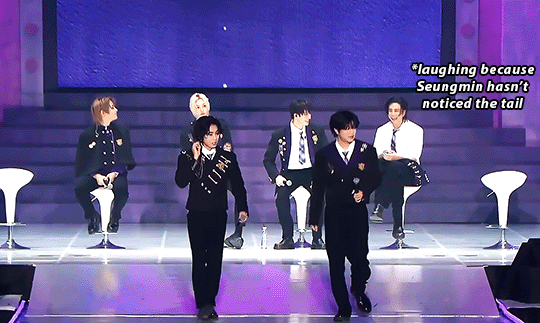
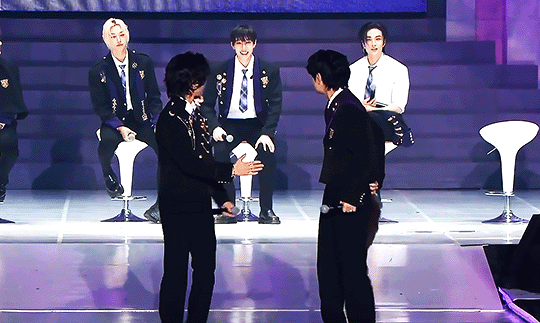

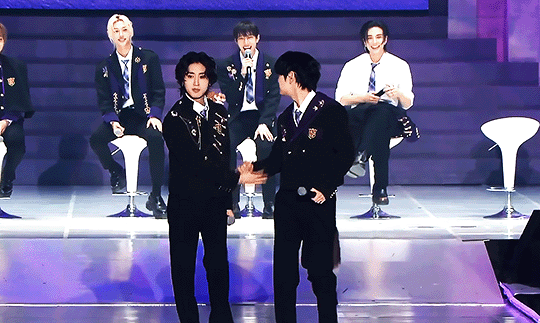
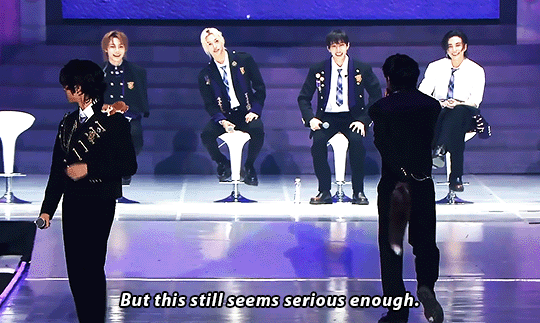
bonus, caught in the act:

#the way chan wasnt even involved but acted like he was#keeping the tail on was the right move though. power move even.#Kim Seungmin#Hwang Hyunjin#bang chan#skz#skz 4th fanmeeting#stray kids#bystay#createskz#staysource#jesskz#skzedit#analook#skz gifs#stray kids gifs#i was gonna say sorry for making 500 seungmin hyunjin gifs but then i realized ive only made 2 sets its just that one had 52 hyunjins#talking about seungmin#so it feels like ive posted a lot but its only 2 posts#seungsung
657 notes
·
View notes
Text
None Of You Know What Haiku Are
I'm going to preface this by saying that i am not an expert in ANY form of poetry, just an enthusiast. Also, this post is... really long. Too long? Definitely too long. Whoops! I love poetry.
If you ask most English-speaking people (or haiku-bot) what a haiku is, they would probably say that it's a form of poetry that has 3 lines, with 5, and then 7, and then 5 syllables in them. That's certainly what I was taught in school when we did our scant poetry unit, but since... idk elementary school when I learned that, I've learned that that's actually a pretty inaccurate definition of haiku. And I think that inaccurate definition is a big part of why most people (myself included until relatively recently!) think that haiku are kind of... dumb? unimpressive? simple and boring? I mean, if you can just put any words with the right number of syllables into 3 lines, what makes it special?
Well, let me get into why the 5-7-5 understanding of haiku is wrong, and also what makes haiku so special (with examples)!
First of all, Japanese doesn't have syllables! There's a few different names for what phonetic units actually make up the language- In Japanese, they're called "On" (音), which translates to "sound", although English-language linguists often call it a "mora" (μ), which (quoting from Wikipedia here) "is a basic timing unit in the phonology of some spoken languages, equal to or shorter than a syllable." (x) "Oh" is one syllable, and also one mora, whereas "Oi" has one syllable, but two moras. "Ba" has one mora, "Baa" has two moras, etc. In English, we would say that a haiku is made up of three lines, with 5-7-5 syllables in them, 17 syllables total. In Japanese, that would be 17 sounds.
For an example of the difference, the word "haiku", in English, has 2 syllables (hai-ku), but in Japanese, はいく has 3 sounds (ha-i-ku). "Christmas" has 2 syllables, but in Japanese, "クリスマス" (ku-ri-su-ma-su) is 5 sounds! that's a while line on its own! Sometimes the syllables are the same as the sounds ("sushi" is two syllables, and すし is two sounds), but sometimes they're very different.
In addition, words in Japanese are frequently longer than their English equivalents. For example, the word "cuckoo" in Japanese is "ほととぎす" (hototogisu).
Now, I'm sure you're all very impressed at how I can use an English to Japanese dictionary (thank you, my mother is proud), but what does any of this matter? So two languages are different. How does that impact our understanding of haiku?
Well, if you think about the fact that Japanese words are frequently longer than English words, AND that Japanese counts sounds and not syllables, you can see how, "based purely on a 17-syllable counting method, a poet writing in English could easily slip in enough words for two haiku in Japanese” (quote from Grit, Grace, and Gold: Haiku Celebrating the Sports of Summer by Kit Pancoast Nagamura). If you're writing a poem using 17 English syllables, you are writing significantly more content than is in an authentic Japanese haiku.
(Also not all Japanese haiku are 17 sounds at all. It's really more of a guideline.)
Focusing on the 5-7-5 form leads to ignoring other strategies/common conventions of haiku, which personally, I think are more interesting! Two of the big ones are kigo, a season word, and kireji, a cutting word.
Kigo are words/phrases/images associated with a particular season, like snow for winter, or cherry blossoms for spring. In Japan, they actually publish reference books of kigo called saijiki, which is basically like a dictionary or almanac of kigo, describing the meaning, providing a list of related words, and some haiku that use that kigo. Using a a particular kigo both grounds the haiku in a particular time, but also alludes to other haiku that have used the same one.
Kireji is a thing that doesn't easily translate to English, but it's almost like a spoken piece of punctuation, separating the haiku into two parts/images that resonate with and add depth to each other. Some examples of kireji would be "ya", "keri", and "kana." Here's kireji in action in one of the most famous haiku:
古池や 蛙飛び込む 水の音
(Furu ike ya kawazu tobikomu mizu no oto)
(The old pond —
A frog jumps in
The sound of the water.)
You can see the kireji at the end of the first line- 古池や literally translates to "old pond ya". The "ya" doesn't have linguistic meaning, but it denotes the separation between the two focuses of the haiku. First, we are picturing a pond. It's old, mature. The water is still. And then there's a frog! It's spring and he's fresh and new to the world! He jumps into the pond and goes "splash"! Wowie! When I say "cutting word", instead of say, a knife cutting, I like to imagine a film cut. The camera shows the pond, and then it cuts to the frog who jumps in.
English doesn't really have a version of this, at least not one that's spoken, but in English language haiku, people will frequently use a dash or an ellipses to fill the same role.
Format aside, there are also some conventions of the actual content, too. They frequently focus on nature, and are generally use direct language without metaphor. They use concrete images without judgement or analysis, inviting the reader to step into their shoes and imagine how they'd feel in the situation. It's not about describing how you feel, so much as it's about describing what made you feel.
Now, let's put it all together, looking at a haiku written Yosa Buson around 1760 (translated by Harold G. Henderson)
The piercing chill I feel:
my dead wife's comb, in our bedroom,
under my heel
We've got our kigo with "the piercing chill." We read that, and we imagine it's probably winter. It's cold, and the kind of cold wind that cuts through you. There's our kireji- this translation uses a colon to differentiate our two images: the piercing chill, and the poet stepping on his dead wife's comb. There's no descriptions of what the poet is feeling, but you can imagine stepping into his shoes. You can imagine the pain he's experiencing in that moment on your own.
"But tumblr user corvidcall!" I hear you say, "All the examples you've used so far are Japanese haiku that have been translated! Are you implying that it's impossible for a good haiku to be written in English?" NO!!!!! I love English haiku! Here's a good example, which won first place in the 2000 Henderson haiku contest, sponsored by the Haiku Society of America:
meteor shower . . .
a gentle wave
wets our sandals
When you read this one, can you imagine being in the poet's place? Do you feel the surprise as the tide comes in? Do you feel the summer-ness of the moment? Haiku are about describing things with the senses, and how you take in the world around you. In a way, it's like the poet is only setting a scene, which you inhabit and fill with meaning based on your own experiences. You and I are imagining different beaches, different waves, different people that make up the "our" it mentioned.
"Do I HAVE to include all these things when I write haiku? If I include all these things, does that mean my haiku will be good?" I mean, I don't know. What colors make up a good painting? What scenes make up a good play? It's a creative medium, and nobody can really tell you you can't experiment with form. Certainly not me! But I think it's important to know what the conventions of the form are, so you can appreciate good examples of it, and so you can know what you're actually experimenting with. And I mean... I'm not the poetry cops. But if you're not interested in engaging with the actual conventions and limitations of the form, then why are you even using that form?
I'll leave you with one more English language haiku, which is probably my favorite haiku ever. It was written by Tom Bierovic, and won first place at the 2021 Haiku Society of America Haiku Awards
a year at most . . .
we pretend to watch
the hummingbirds
Sources: (x) (x) (x) (x) (x) (x)
Further reading:
Forms in English Haiku by Keiko Imaoka
Haiku: A Whole Lot More Than 5-7-5 by Jack
How to Write a Bad Haiku by KrisL
Haiku Are Not a Joke: A Plea from a Poet Who Has Had It Up to Here by Sandra Simpson
Haiku Checklist by Katherine Raine
#poetry#haiku#writing#literature#anime life#long post#i want to apologize but i had to get something off my chest#and the thing was. i love haiku#and when i see posts on here about haiku. i get so angy.#well ok i really get more disappointed bc nobody is really engaging with the form on its own terms#anyway i hope you enjoy some of my favorite haiku because theyre in there!!!!!#i didnt really get into the history of haiku. and i also did not get into why i got really into it#but i will say that i was really inspired by Jacob Geller's video A Thousand Ways of Seeing a Forest#which is a lot about translation#(which i mean. as an interpreter AND a poetry-enjoyer. really appealed to me lol)
10K notes
·
View notes
Text
my gun-loving, car guy, "i'm the straightest man i know" brother who just finished baldur's gate 3 talking about astarion:

#astarion#baldur's gate 3#we had a long conversation about the end of the game#mostly about astarion and karlach#he says he took multiple days to decide how to handle karlach's ending :`D#but i was just so amused by his reaction to astarion lol#he's like ''i loved my paladin's bromance with astarion! he's my best friend!'#and i was like ''oh that's nice i never even got out of neutral approval with him when i was playing paladin''#and he was like ''you can check characters' approval? o.O''#so while astarion was def his paladin's best friend‚ i'm not so sure his paladin was astarion's best friend if you know what i mean 😂#he was also unhappy that his character just let astarion run off at the end without trying to follow him and make sure he was okay#and at gale for making a snarky comment about it#he was like ''i should have let him ascend 😭''#''if this was real life i wouldn't just let my friend run off like that!''#also: ftr despite my facetious description above let it be known that my brother is the kindest most accepting brother a dyke could ask for#he just also has a lot of stereotypical ''straight guy'' interests
1K notes
·
View notes
Text
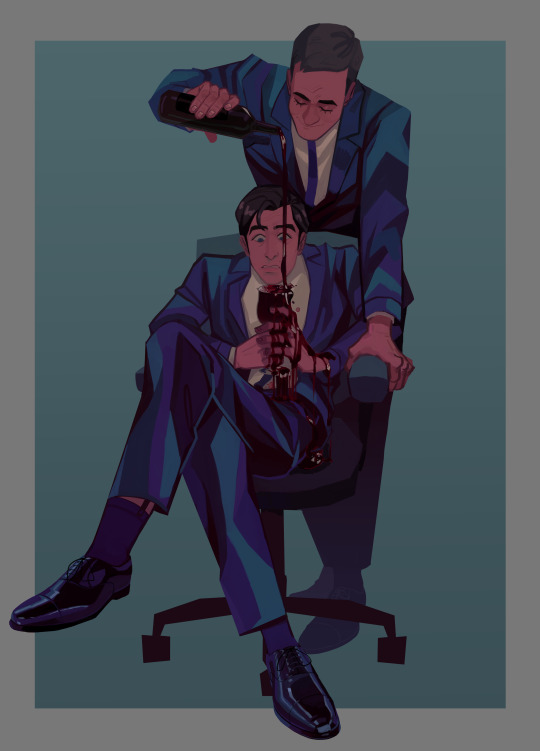
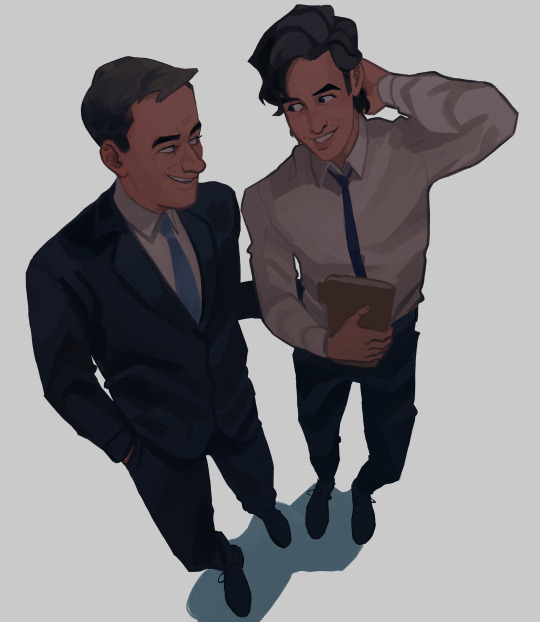

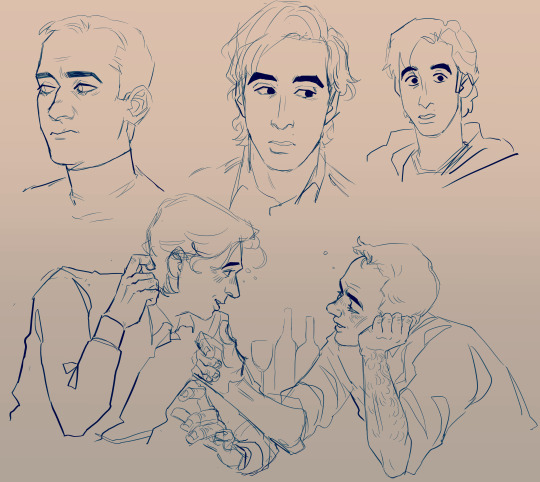
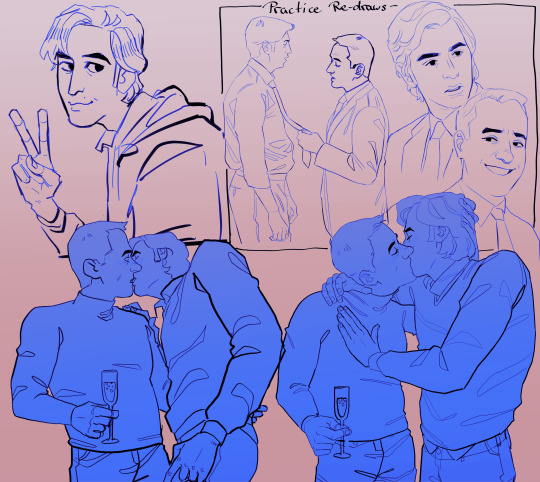
Uploading all my Tomgreg art at once from the past few week before season 4 hits, who knows in what kind of mental state i'm gonna be once it does :')
#tomgreg#succession#dont even talk to me i started watching this show when i had nothing to do at work and now i watch it with averiel my good friend averiel#and we are going to watch s4 together and i feel physically ill from bein so excited#so ya thats what ive been up to... anyway. i love these idiots they desever nothing but the worst (affectionate)#im also a tomshiv lover btw. im the one who yells 'THIS IS HOW TOMSHIV CAN STILL WIN' while they are actively losing on screen#thats the kind of person i am#dont look at me (lying on the floor)#okay i was not going to say stuff in the tags and let the art speak for itself but i NEED to point out details in the wine Painting..#i put a lot of work into that one. thinly veiled metaphors and symbolism yknow..#greg is gripping the stem of the wine glass with his full fist. tom and greg are dressed in the same outfit (sock garters included)#greg look appalled but he is not doing anything about the spill. tom is fondly pouring greg more and more wine. he is doing him a favor#i colored the red wine the same way i would color blood :) oh and tom is not really touching greg#only holding the chair in place. greg is making himself look smaller than he is like usual#oh and @ the person who said that it's the inverse of the tom and nate scene i love the way you think. i did not think of that before#but god. yeah. i actually thought about the scene change from when roman uhh.. christens his office in s1. the one with the coffee machine#i always go insane at that cut. this is not exactly the same since it's more.. about emotions but yknow.. it can be.. the same...
4K notes
·
View notes
Note
what do you mean youre technically a detransitioner cause of terf bullshit?
it's a v long story but i detransitioned for a couple of years when i was 16/17, for multiple reasons but mostly because i fell into the blaire white/kalvin garrah chamber of "you have to be This way to be trans otherwise you're not real".
i was already Deeply insecure about myself and my 'passing' and i was led to believe that i couldn't want to wear makeup or skirts, and i couldn't choose not to have bottom surgery, and i couldn't do anything but bind for 12+ hours a day to the point that my ribcage is still misshapen. basically i thought that if i wasn't suffering enough doing 'feminine' things, i couldn't really be trans, so i should just go back to being a girl and suck it up.
the terf bullshit is because i'd seen a lot of terfs/detransitioners talking about the 'dangers' of testosterone and how it would turn me into a horrible ugly evil monster and how there was nothing worse than wanting to be a man. which combined with 'you need to fully medically transition to be valid at all' creates some very dangerous and upsetting feelings to cope with.
it also came from trying really hard to put myself in a little box before i realised that my sexuality/gender are very fluid and it's FINE for me not to have a label and just do whatever i want. when i was 19 or so i went back to using they/them (and eventually he/him) and changed my name again because even though i like doing 'feminine' things, i don't want to be seen as a woman.
tldr: i was conditioned by transphobic/terf rhetorics to think that i was being trans the 'wrong' way so i couldn't be trans at all, so i believed i must actually be a girl if i still wanted to do 'feminine' things. nowadays i am a transmasc who does feminine things because i don't give two shits about what any transmed prick thinks of me anymore.
#ramble#ok to reblog btw i'm fine with this being shared#this was meant to be a short version but this is just the whole story whoops#sorry i realised the way i phrased it sounded like i'm the detrans you see in the news#i'm Technically a detransitioner because a lot of detrans stats are people who go on to RETRANSITION#because detransition is often because of social stigma and not because you realised you weren't trans#so anyway. terfs are cancer and if you don't think their bs is harming children you're wrong#i know it's easy to say 'you should've used your brain and realised those people were wrong'#but like. when you're 16 you're SO impressionable. even if you think you aren't#especially when you're watching people who have been transitioning longer than you and you assume they know everything#i was in my mid-late teens when 'transtrender' videos were MASSIVE and i believed it!!! and i was Not nice about those people#all they made me believe was that being trans couldn't be colourful and comfy and fun. it just had to be Pain#i hope everyone who contributed to the 'you need to be this way to be trans' mindset knows how much hurt they've caused#nowadays i don't care. go and be stargender. we have actual problems to deal with not debates about neopronouns#anyway this was long. that's the story
546 notes
·
View notes
Text
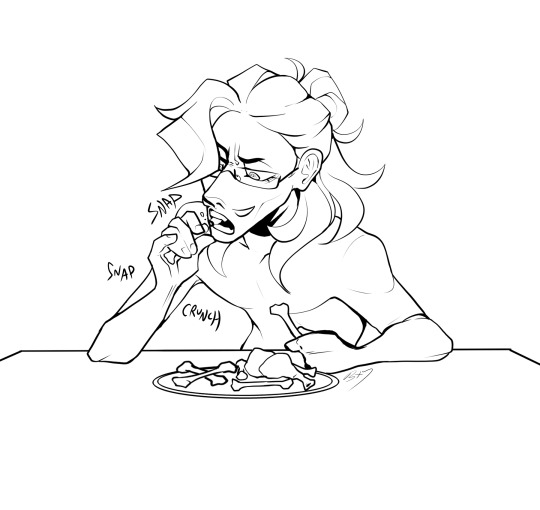

#Saw a man bite straight through a chicken bone on YouTube.#I was gripped. In awe.#A jaw strength rivaled only by - I thought to myself - Present Mic#can't even remember how I got onto the video but it's stuck with me ever since#he had a captivating positive vibe. I would enjoy a meal with him. The chicken looked a little underdone though#bnha#mha#shouta aizawa#hizashi yamada#present mic#bnha comic#not even technically a comic this bad boy is two slides#always thinking about the rooftop gang naming Sushi like 'whats everyones favourite food?'#and Yamada says 'fried chicken' like that would be the best name for a cat- actually. you know what. that is a pretty good name for a cat#Might call my next tarantula Fried Chicken. Who knows?#Edited the last panel to take out the speech bubble cause it looked like I was implying it was weird to eat bone marrow#But I meant the entire bone itself like the crunchy bit#But apparently they do that in some places so I thought that it might come across as a bit insensitive and I didnt wanna get cancelled.#eat bones if you want I would love to eat bones but I'm a coward#It's not really a thing in the UK I don't think. I've never seen anyone do it. I guess we just produce a lot of food waste.#so nobody was going to tell me you could eat bones? I just had to find out myself on Youtube?
426 notes
·
View notes